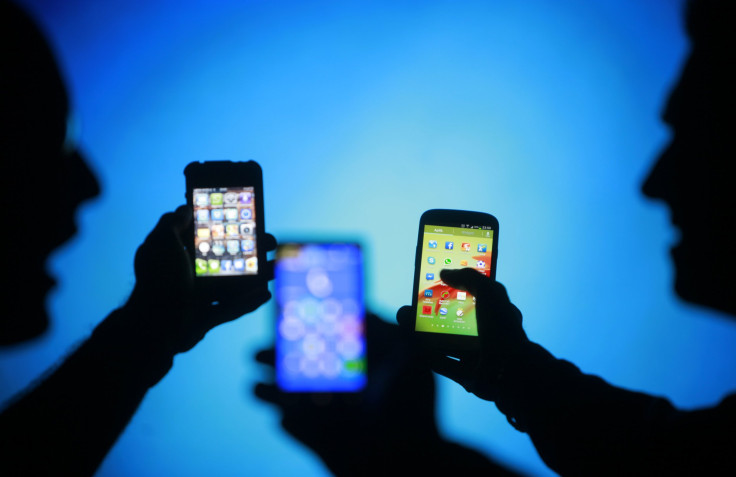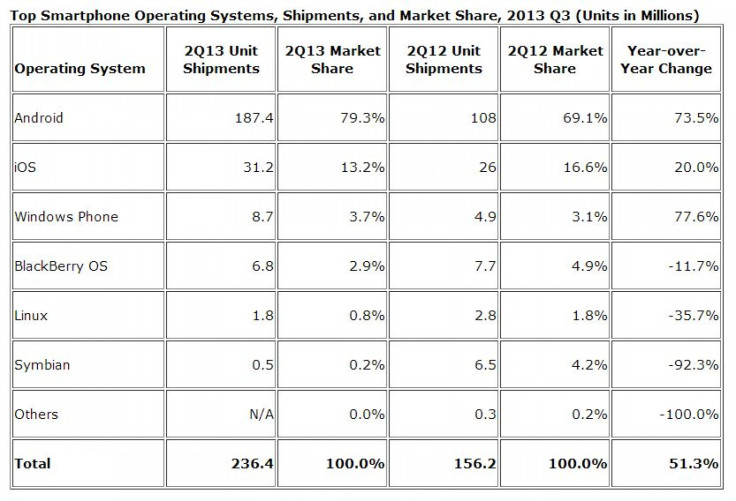Android Gains In Smartphone OS Market With 80% Share In Q2 As iOS Falls Behind; Will iOS 7 Revive Apple’s OS Fortunes?

Google’s (NASDAQ:GOOG) Android maintained its lead in the worldwide smartphone operating system market in the second quarter of this year, while Apple’s (NASDAQ:AAPL) iOS posted a year-on-year drop in its market share during the same period, according to data from the International Data Corporation, or IDC.
Out of 236.4 million smartphones shipped globally in the second quarter of 2013, Android powered 187.4 million units and captured a whopping 79.3 percent of market share, which was up 10.2 percentage points from 69.1 percent a year earlier.
“Android maintained its leadership position, with strong contributions from Samsung and its Galaxy S4. Not to be overlooked were LG and Chinese vendors Huawei (SHE:002502), Lenovo (HKG:0992), and ZTE (SHE:000063), which each recorded double-digit shipment volumes in the millions,” an IDC statement said. “Combined, these vendors accounted for 62.5% of all Android-powered smartphone shipments during the quarter.”
Apple iOS came in second on the list but suffered a decline in market share, despite shipping 5.2 million more iPhones during the period and beat analysts’ expectations of shipment volumes. The Cupertino, Calif.-based tech giant shipped 31.2 million iPhones in the second quarter of 2013 and accounted for 13.2 percent of the market share, down from 16.6 percent in the second quarter of 2012.
“The iOS decline in the second quarter aligns with the cyclicality of iPhone,” Ramon Llamas, research manager at IDC, said in the statement. “Without a new product launch since the debut of the iPhone 5 nearly a year ago, Apple’s market share was vulnerable to product launches from the competition.”
However, Llamas believes that the upcoming iPhone 5S and the company’s revamped iOS 7, releasing later this year, will help Apple revive its fortune by re-positioning itself to capture more market share.
According to IDC, iOS managed to finish the quarter as the clear No. 2 platform with demand staying strong despite an absence of new product launches. And, Apple added new mobile operators to its camp, which boosted its short-term volumes and strengthened its long-term end-user relationships.
“What remains to be seen is how the new iOS 7 will be received once it reaches the market later this year, as much of the look and feel of the user interface has been revamped,” the statement said.
Microsoft’s (NASDAQ:MSFT) Windows Phone shipments, which surpassed BlackBerry's in the first quarter of this year, continued to do so in the second quarter as well. Windows Phone posted the largest year-on-year increase among the top five smartphone platforms, and in the process reinforced its position as the No. 3 smartphone OS.
Windows Phone powered 8.7 million smartphones in the second quarter of 2013, which helped it capture 3.7 percent of the market share, up from 3.1 percent during the same period last year with a shipment of 4.9 million units.
“Nokia (NYSE:NOK) has clearly been the driving force behind the Windows Phone platform and we expect that to continue,” Ryan Reith, program manager at IDC, said. “However, as more and more vendors enter the smartphone market using the Android platform, we expect Windows Phone to become a more attractive differentiator in this very competitive market segment.”
BlackBerry (NASDAQ:BBRY) OS and Linux rounded out the top five list by accounting for 2.9 percent and 0.8 percent share of the smartphone market in the second quarter, respectively.

© Copyright IBTimes 2025. All rights reserved.





















